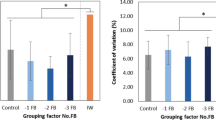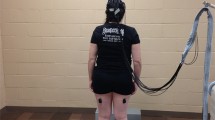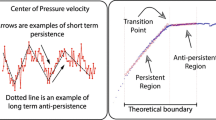Abstract
Movement science has traditionally understood high-dimensional fluctuations as either antithetical or irrelevant to low-dimensional control. However, fluctuations incident to changeful, sometimes unpredictable stimulation must somehow reshape low-dimensional aspects of control through perception. The movement system’s fluctuations may reflect cascade dynamics in which many-sized events interact nonlinearly across many scales. Cascades yield fractal fluctuations, and fractality of fluctuations may provide a window on the interactions across scale supporting perceptual processes. To test these ideas, we asked adult human participants to judge whole or partial length for unseen rods (with and without added masses). The participants’ only experience with the objects came from supporting them across their shoulders during quiet standing. First, the degree of fractal temporal correlations in trial-by-trial series of planar Euclidean displacements in center of pressure (COP) significantly improved prediction of subsequent trial-by-trial judgments, above and beyond prediction by traditional predictors of haptic perception and conventional measures of COP variability. Second, comparison with linear surrogate data indicated the presence of nonlinear interactions across scale in these time series. These results demonstrate that high-dimensional fluctuations may serve a crucial role in the cascade dynamics supporting apparently low-dimensional control strategies.





Similar content being viewed by others
References
Anastas, J. R., D. G. Stephen, and J. A. Dixon. The scaling behavior of hand motions reveals self-organization during an executive-function task. Phys. A 390:1539–1545, 2011.
Berniker, M., A. Jarc, E. Bizzi, and M. C. Tresch. Simplified and effective motor control based on muscle synergies to exploit musculoskeletal dynamics. Proc. Nat. Acad. Sci. USA 106:7601–7606, 2009.
Bernstein, N. A. The Coordination and Regulation of Movements. Oxford: Pergamon Press, p. 196, 1967.
Bloch-Salisbury, E., P. Indic, F. Bednarek, and D. Paydarfar. Stabilizing immature breathing patterns of preterm infants using stochastic mechanosensory stimulation. J. Appl. Physiol. 107:1017–1027, 2009.
Carello, C., M.-V. Santana, and G. Burton. Selective perception by dynamic touch. Percept. Psychophys. 58:1177–1190, 1996.
Collins, J. J., T. T. Imhoff, and P. Grigg. Noise-enhanced tactile sensation. Nature 383:770, 1996.
Delignières, D., S. Ramdani, L. Lemoine, K. Torre, M. Fortes, and G. Ninot. Fractal analyses for “short” time series: a re-assessment of classical methods. J. Math. Psychol. 50:525–544, 2006.
Dixon, J. A., J. G. Holden, D. Mirman, and D. G. Stephen. Multifractal dynamics in the emergence of cognitive structure. Topics Cogn. Sci. 4:94–102, 2012.
Duarte, M., and V. M. Zatsiorsky. Long-range temporal correlations in human standing. Phys. Lett. A 283:124–128, 2001.
Ihlen, E. A. F., and B. Vereijken. Interaction-dominant dynamics in human cognition: beyond 1/f α fluctuation. J. Exp. Psychol. Gen. 139:436–463, 2010.
Ivanov, P. Ch., L. A. N. Amaral, A. L. Goldberger, S. Havlin, M. G. Rosenblum, H. E. Stanley, and Z. R. Struzik. From 1/f noise to multifractal cascades in heartbeat dynamics. J. Nonlinear Sci. 11:641–652, 2001.
Kantelhardt, J. W., S. A. Zschiegner, E. Koscielny-Bunde, S. Havlin, A. Bunde, and H. E. Stanley. Multifractal detrended fluctuation analysis of nonstationary time series. Phys. A 316:87–114, 2002.
Kelty-Stephen, D. G., and J. A. Dixon. Temporal correlations in postural sway moderate effects of stochastic resonance on postural stability. Hum. Mov. Sci. (in press).
Kuznetsov, N. A., and S. Wallot. Effects of accuracy feedback on fractal characteristics of time estimation. Front. Integr. Neurosci. 5:62, 2011.
McDonnell, M. D., and D. Abbott. What is stochastic resonance? Definitions, misconceptions, debates, and its relevance to biology. PLoS Comp. Biol. 5:e1000348, 2009.
Nozaki, D., J. J. Collins, and Y. Yamamoto. Mechanism of stochastic resonance enhancement in neuronal models driven by 1/f noise. Phys. Rev. E 60:4637–4644, 1999.
Palatinus, Zs., C. Carello, and M. T. Turvey. Principles of part-whole selective perception by dynamic touch extend to the body. J. Mot. Behav. 43:87–93, 2011.
Peng, C.-K., S. Havlin, H. E. Stanley, and A. L. Goldberger. Quantification of scaling exponents and crossover phenomena in nonstationary heartbeat time series. Chaos 5:82–87, 1995.
Peng, C.-K., J. E. Mietus, Y. Liu, C. Lee, J. M. Hausdorff, H. E. Stanley, A. L. Goldberger, and L. A. Lipsitz. Quantifying fractal dynamics of human respiration: age and gender effects. Ann. Biomed. Eng. 30:683–692, 2002.
Priplata, A. A., J. B. Niemi, J. D. Harry, L. A. Lipsitz, and J. J. Collins. Vibrating insoles and balance control in elderly people. Lancet 362:1123–1124, 2003.
Schreiber, T., and A. Schmitz. Improved surrogate data for nonlinearity tests. Phys. Rev. Lett. 77:635–638, 1996.
Singer, J. D., and J. B. Willett. Applied Longitudinal Data Analysis. New York: Oxford University Press, p. 644, 2003.
Stephen, D. G., R. Arzamarski, and C. F. Michaels. The role of fractality in perceptual learning: exploration in dynamic touch. J. Exp. Psychol. Hum. Percept. Perform. 36:1161–1173, 2010.
Stephen, D. G., R. A. Boncoddo, J. S. Magnuson, and J. A. Dixon. The dynamics of insight: mathematical discovery as a phase transition. Mem. Cogn. 37:1132–1149, 2009.
Stephen, D. G., and J. A. Dixon. Strong anticipation: multifractal cascade dynamics modulate scaling in synchronization behaviors. Chaos Solitons Fractals 44:160–168, 2011.
Stephen, D. G., and A. Hajnal. Transfer of calibration between hand and foot: functional equivalence and fractal fluctuations. Attent. Percept. Psychophys. 73:1302–1328, 2011.
Stephen, D. G., N. Stepp, J. A. Dixon, and M. T. Turvey. Strong anticipation: sensitivity to long-range correlations in synchronization behavior. Phys. A 387:5271–7278, 2008.
Stephen, D. G., B. Wilcox, J. B. Niemi, J. D. Franz, D. C. Kerrigan, and S. E. D’Andrea. Baseline-dependent effect of noise-enhanced insoles on gait variability in healthy elderly walkers. Gait Posture 36:537–540, 2012.
Stoffregen, T. A., C.-M. Yang, and B. G. Bardy. Affordance judgments and nonlocomotory body movements. Ecol. Psychol. 17:75–104, 2005.
Suki, B. Fluctuations and power laws in pulmonary physiology. Am. J. Respir. Crit. Care Med. 166:133–137, 2002.
Teich, M. C., C. Heneghan, S. B. Lowen, T. Ozaki, and E. Kaplan. Fractal character of the neural spike train in the visual system of the cat. J. Opt. Soc. Am. A 14:529–546, 1997.
Turcotte, D. L., B. D. Malamud, F. Guzzetti, and P. Reichenbach. Self-organization, the cascade model, and natural hazards. Proc. Natl. Acad. Sci. 19:2463–2465, 2002.
Turvey, M. T. Action and perception at the level of the synergies. Hum. Mov. Sci. 26:657–697, 2007.
Turvey, M. T., and C. Carello. Obtaining information by dynamic (effortful) touching. Phil. Trans. R. Soc. B 366:3123–3132, 2011.
Zheng, Y., J. Gao, J. C. Sanchez, J. C. Principe, and M. S. Okun. Multiplicative multifractal modeling of human neuronal activity. Phys. Lett. A 344:253–264, 2005.
Acknowledgments
The authors thank M. T. Turvey for helpful discussions, J. G. Holden and two anonymous reviewers for their helpful comments, and acknowledge NSF grant BCS-0925373 and the Wyss Institute for financial support.
Conflict of interest
The authors have no conflicts of interests related to and reap no financial benefits from presenting the work reported in the manuscript.
Author information
Authors and Affiliations
Corresponding author
Additional information
Associate Editor Thurmon E. Lockhart oversaw the review of this article.
Rights and permissions
About this article
Cite this article
Palatinus, Z., Dixon, J.A. & Kelty-Stephen, D.G. Fractal Fluctuations in Quiet Standing Predict the Use of Mechanical Information for Haptic Perception. Ann Biomed Eng 41, 1625–1634 (2013). https://doi.org/10.1007/s10439-012-0706-1
Received:
Accepted:
Published:
Issue Date:
DOI: https://doi.org/10.1007/s10439-012-0706-1




